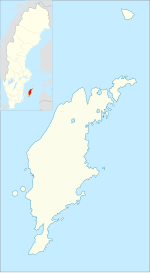Bunge Church
| Bunge Church | |
|---|---|
| Bunge kyrka | |

Bunge Church, external view
|
|
| 57°51′13″N 19°01′25″E / 57.8537°N 19.0235°ECoordinates: 57°51′13″N 19°01′25″E / 57.8537°N 19.0235°E | |
| Location | Bunge |
| Country | Sweden |
| Denomination | Church of Sweden |
| Administration | |
| Diocese | Visby |
Bunge Church (Swedish: Bunge kyrka) is a medieval Lutheran church in Bunge on the Swedish island of Gotland, in the Diocese of Visby (Sweden).
Archaeological excavations carried out in 1916 and 1971 have shown that the present, mainly Gothic church was pre-dated by a Romanesque church, dating from the 12th century. The massive, fortress-like tower of the church is somewhat later but belonged to this first edifice. The nave and choir were built in the 14th century in a form of High Gothic typical for Gotland: the nave is high and spacious, divided into two by slender columns; the choir lacks an apse; and the east end of the church instead finishes in a straight wall adorned with three slender windows.
The church and churchyard are surrounded by a wall which originally reached much higher and had a defensive purpose. Four medieval gates still survive in the wall. The church complex evidently has fulfilled a defensive role, as there are marks from pikes and crossbow bolts in the sturdy tower-door, still preserved in its original place. In addition, the inside of the church is profusely decorated with frescos depicting, among other things, fighting knights. The frescos and the church wall may date from the short period in history when Gotland belonged to the Teutonic Order. This has led some scholars to speculate whether the church for a time might have been owned by the crusading Order, and turned into an Ordensburg (albeit on a small scale).
The church is one of the largest on northern Gotland. As mentioned, it displays a mix between Romanesque (the tower) and Gothic (the nave and choir). The church has a finely carved southern portal, rich in sculpture, and a northern portal with Romanesque details, possibly also incorporated from the earlier church building.
...
Wikipedia

